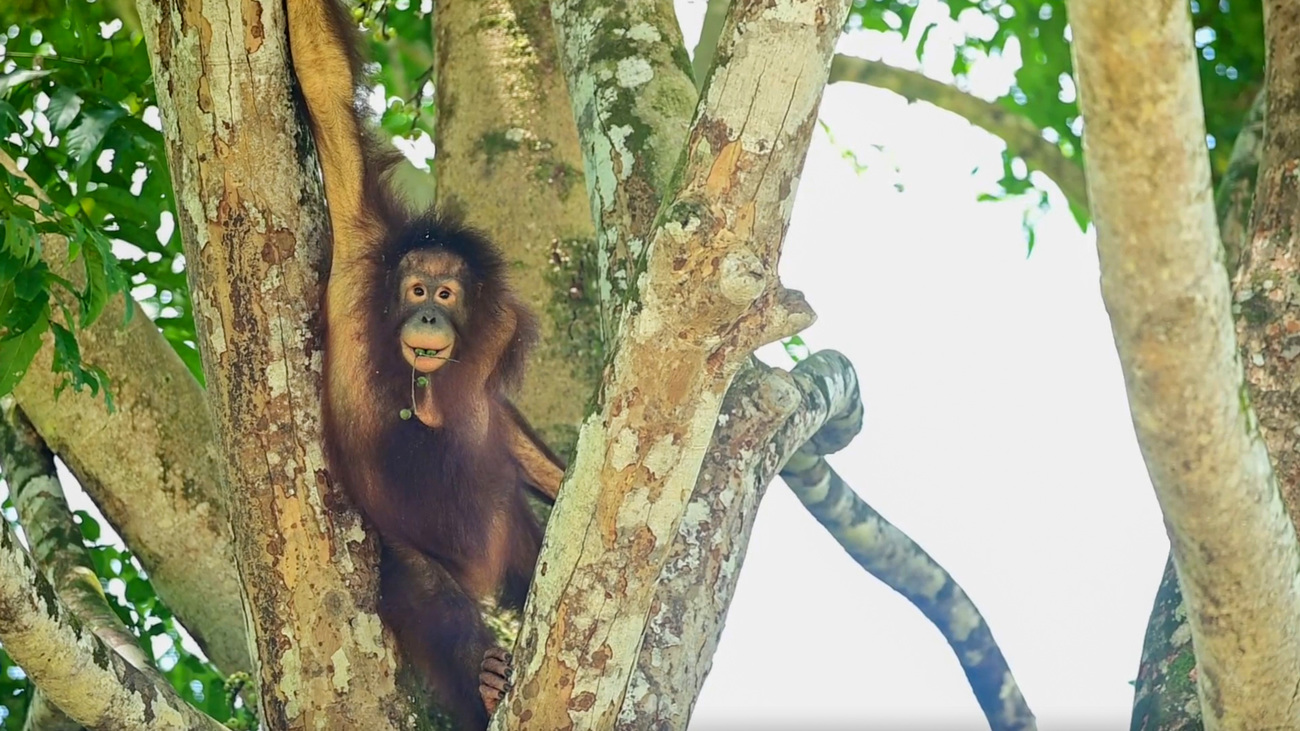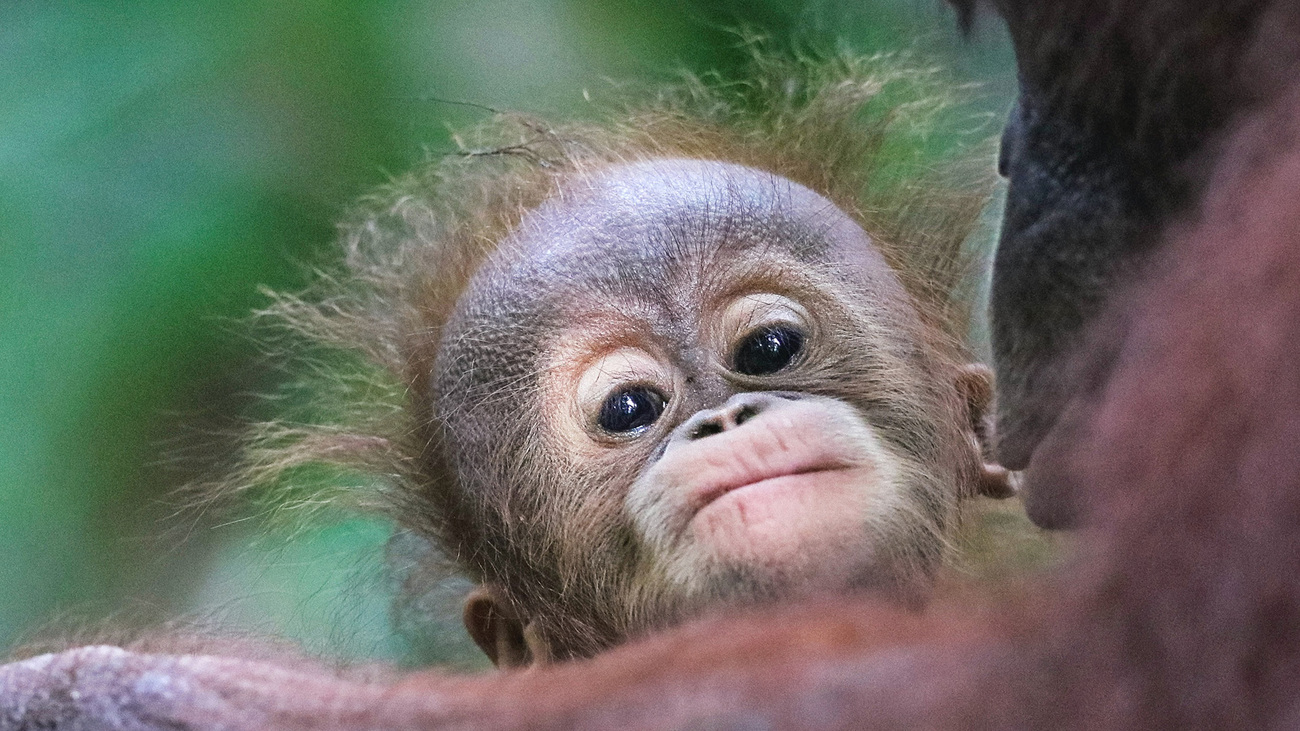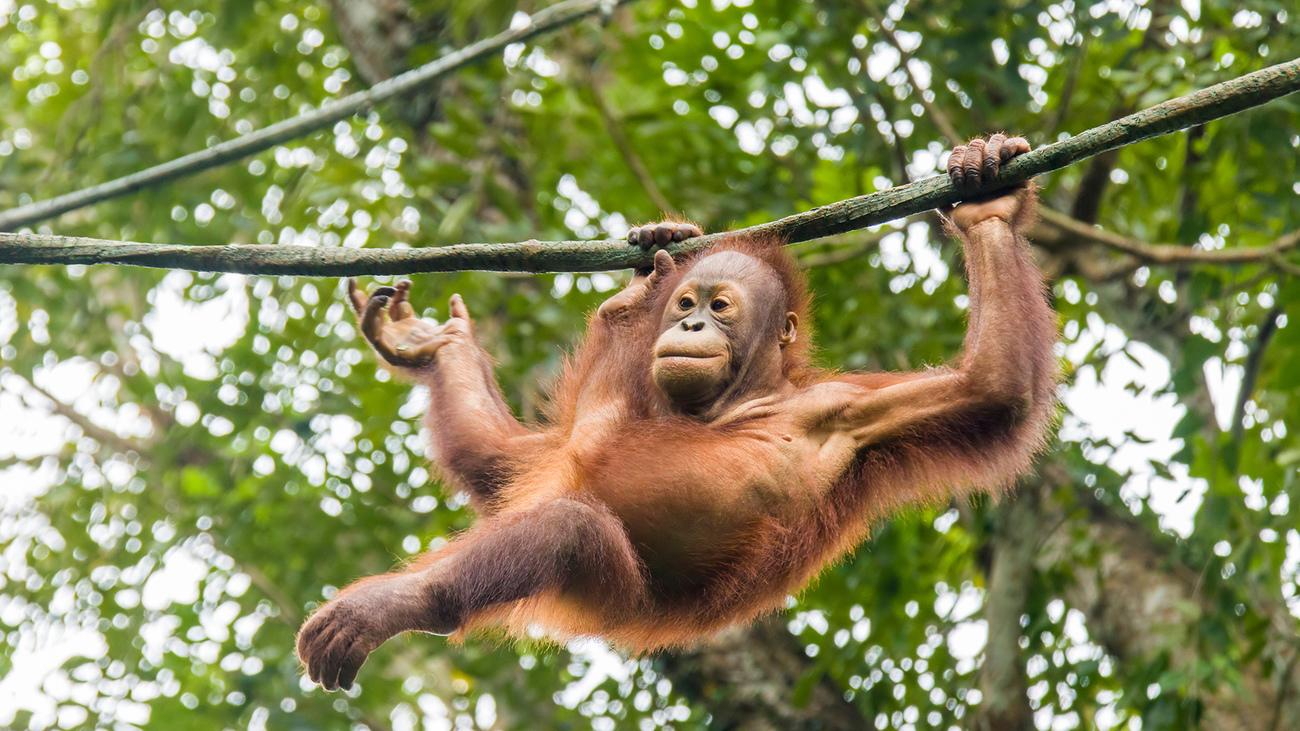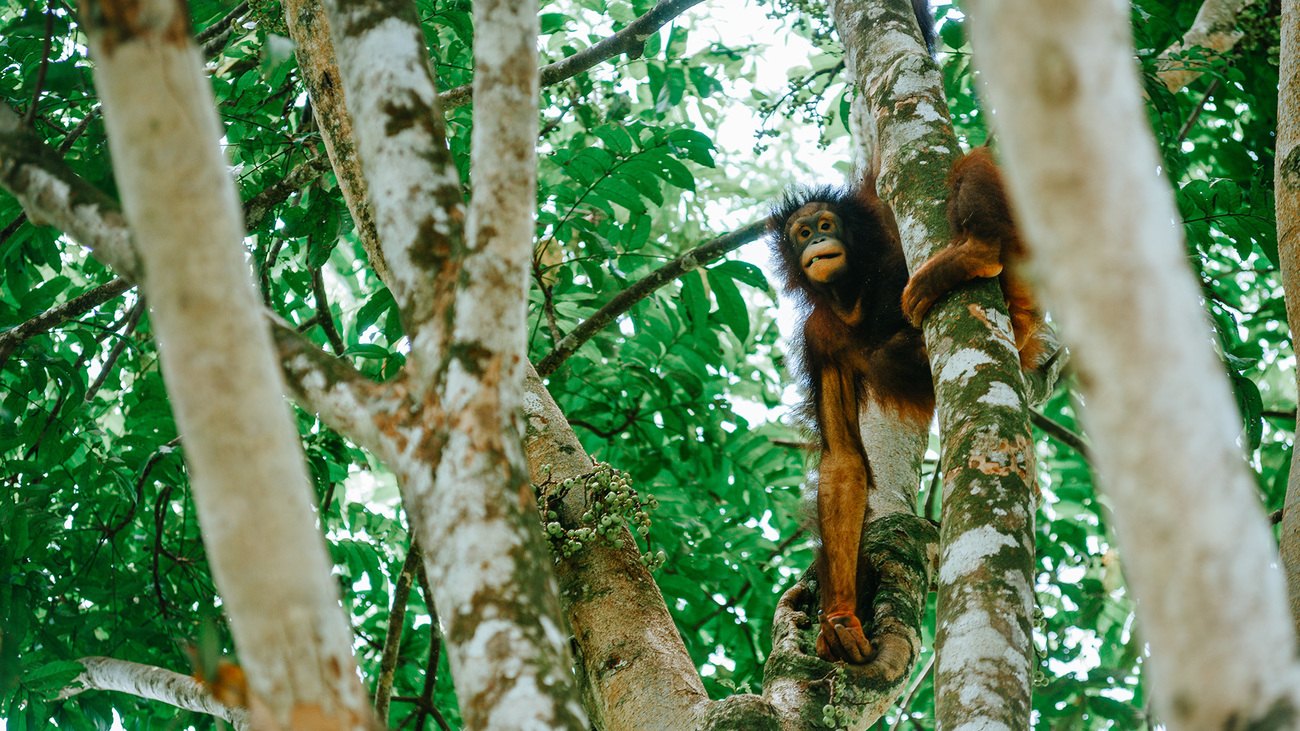Orangutans
Fascinating, intelligent, and incredibly agile, orangutans are one of the most unique species on our planet. These reddish-brown great apes are native to the dense rainforests of Sumatra and Borneo and have evolved to become the largest tree-dwelling mammals. With their long, powerful arms and curved hands and feet, they’ve mastered an arboreal life, spending roughly 90% of their time amidst the high tree canopies.
Orangutans have distinct physical characteristics. Males can reach heights of about 1.5 metres (4’9”), and females 1.2 metres (3’9”). Male orangutans can weigh 93-103 kilograms (205 to 227 pounds), while females are much lighter, weighing 48-55 kilograms (105-131 pounds). They also have long lifespans; an average orangutan will often live for 30-40 years or more.
Orangutans communicate with facial expressions, body language, and vocalisations like kiss-squeaks and belching. Males also use a deeply resonating long call to communicate and maintain distance from other males.
Other physical characteristics include flabby throat sacs found in male orangutans. These tend to become very large as they reach adulthood. They also develop large cheek pads, which amplify their long calls; these can be heard from over a kilometre away and demonstrate their genetic fitness to potential mates. Their diets can be described as frugivorous, meaning that they consume a wide variety of fruits, flowers, leaves, insects, and other vegetation.
The word orangutan translates to ‘person of the forest’ in Malay. They are strikingly similar to humans, sharing 97% of our DNA. They exhibit immense intelligence, demonstrated through their problem-solving abilities and their knack for using tools to access hard-to-reach food. These abilities—combined with their patient demeanour—make orangutans truly captivating creatures.
One characteristic feature of orangutans is their largely solitary nature. Males tend to be loners, covering vast territories and interacting with others primarily for mating.
Female orangutans have a more complex social structure. They often form strong bonds with their offspring and give birth once every eight years. Baby orangutans are dependent on their mothers for about six to seven years—the longest childhood among the great apes. Orangutans have a gestation period of 8.5 months and typically give birth to a single offspring—they are quite similar to humans in this way.
Despite their impressive strength and adaptability, orangutans are critically endangered. They are threatened by human activities like deforestation through logging and hunting. Their survival is becoming increasingly precarious as their homes are rapidly disappearing due to palm oil plantations, logging, fires, and other forms of habitat destruction.
Orangutans play an integral role in maintaining the health and diversity of their rainforest habitats. In fact, they are called the gardeners of the forest. By breaking branches and foliage as they travel, orangutans create pathways that are utilised by smaller species. This contributes to the overall fluidity and dynamism of the forest environment.
Healthy orangutan populations also indicate a healthy forest, as they rely on a wide range of resources the forest offers. They are often considered an umbrella species, meaning their conservation indirectly protects many other species and the entire ecosystem.
What is an orangutan’s scientific name?
The orangutan belongs to the genus Pongo within the great ape family, Hominidae. They are unique among great apes as being native to Asia rather than Africa. There are three recognised species: the Bornean Orangutan (Pongo pygmaeus), the Sumatran Orangutan (Pongo abelii), and the Tapanuli Orangutan (Pongo tapanuliensis).
Are orangutans endangered?
Yes. Unfortunately, all three species of orangutans are classified as critically endangered by the International Union for Conservation of Nature (IUCN).
Where do orangutans live?
The main Orangutan habitat is in the lush, tropical rainforests of Sumatra and Borneo in Southeast Asia. Orangutans typically live in dense forests, where they dwell high in the trees. Orangutans are the world’s largest tree-dwelling animals, and this arboreal lifestyle is supported by their long arms and curved fingers. These features are ideal for swinging from branch to branch in what is known as arboreal clambering.
Their habitats are typically lowland rainforests, peat swamp forests, and montane forests, depending on the species. They use large leaves as makeshift umbrellas and shelters, displaying their ingenuity and adaptation to their environment. Orangutans have shaped and been shaped by their habitats, playing a crucial role in their ecosystems.
Threats
The orangutan faces numerous severe threats. Human activities have led to conditions that make their survival increasingly challenging, pushing this magnificent species to the brink of extinction. The three primary threats that endanger these great apes are habitat destruction, hunting, and fires.

Habitat destruction
Habitat destruction poses a significant threat to orangutans, as they spend most of their time in the trees and are therefore very vulnerable to logging and deforestation. One of the primary causes of habitat destruction is deforestation, which involves large-scale clearing of forests for commercial purposes like logging, agriculture (specifically palm oil plantations), and mining.
The expansion of the palm oil industry poses a major threat to orangutans’ habitats. Forests are often cleared to make way for palm oil plantations, resulting in the loss of critical areas that orangutans need to survive. The demand for this versatile oil has skyrocketed in recent decades, fueling rapid deforestation.
Human encroachment on orangutan habitats is another contributor. As human populations expand, settlements, infrastructure development, and agriculture further diminish suitable areas for orangutans. Human activities fragment orangutan habitats and restrict their ability to find enough resources.
Hunting
Hunting poses a significant threat to the survival of orangutans. There are a number of reasons why these primates are hunted, and each contributes to their declining populations. One major reason for hunting orangutans is poaching. Orangutans are often sought after in the illegal wildlife trade. Baby orangutans are particularly targeted as pets. Unfortunately, this means they are often captured and sold on the black market, causing immense suffering and disruption. Adult orangutans may be hunted and killed for specific body parts like skulls and bones that hold value in traditional medicine.
The bushmeat trade also targets orangutans and puts pressure on dwindling population numbers. Hunting disrupts not only individual orangutan lives but entire communities’ social structure. The loss of adult males can lead to imbalances in mating opportunities within populations, impacting reproductive success and overall health dynamics.
Fires
Fires pose a significant threat to orangutans and their survival. They can have devastating consequences for the vegetation and plant life on which orangutans rely. The destruction of fruit-bearing trees, leaves, and other food sources can lead to scarcity and nutritional stress. Without an adequate supply of food, their health deteriorates. This puts them at risk of malnutrition and even death.
In addition to the loss of food sources, smoke inhalation also endangers orangutans. Inhaling this smoke can result in respiratory problems and other health complications that make them more vulnerable to diseases and infections.
Fires often originate from human activities like land clearing for agriculture or logging. As a consequence of these fires destroying their habitat, orangutans may be forced to venture into human settlements to find food and shelter. This increased proximity between humans and orangutans significantly raises the potential for conflicts between the two groups.
FAQs
What do orangutans eat?
The orangutan diet consists mostly of fruit. They consume a wide variety of fruits, like figs, durian, and mangoes. Besides fruit, they also eat leaves, flowers, bark, and insects. Since they eat so much fruit, they play a crucial role in seed dispersal through their faeces. Orangutans can travel long distances while eating fruit and defecating seeds along the way. This helps maintain the forest’s biodiversity by spreading seeds to new areas where trees can grow and thrive.
How many orangutans are left in the world?
Approximately 104,000 Bornean orangutans are left in the world. This number is an estimate based on recent surveys and population studies. Unfortunately, their population has been declining due to habitat loss and illegal hunting, among other factors.
Sumatran orangutans are even more critically endangered, with only around 13,000 remaining. Their numbers have also been affected by deforestation for palm oil plantations and logging.
Lastly, we have the Tapanuli orangutan, which is a newly discovered species with less than 800 individuals left. Their small population size makes them incredibly vulnerable to extinction.
How much does an orangutan weigh?
Adult male orangutans typically weigh between 93 to 103 kilograms (205 to 227 pounds), while the females, who are smaller, usually weigh between 48 to 55 kilograms (105-131 pounds). The significant size difference between males and females is a clear demonstration of sexual dimorphism, a common characteristic in many primate species.

How big are orangutans?
Adult male orangutans can reach a height of about 1.5 metres (4’9”) when standing upright on two legs. Adult female orangutans tend to be slightly smaller, measuring approximately 1.2 metres (3’9”) when standing upright.
Despite their short stature, orangutans display an astonishing amount of agility and strength in the treetops. They have long arms and strong muscles adapted for climbing trees, which makes them well-suited for life in the forest canopy.
Why are orangutans endangered?
Orangutans face numerous threats pushing them towards extinction. One major threat they face is habitat destruction, as their rainforest homes in Southeast Asia are being cleared for agriculture and logging. This is largely due to palm oil cultivation, and this loss of habitat limits orangutans’ access to food and shelter.
Another significant issue is the occurrence of fires in these forests. Often started intentionally for land clearing, these fires devastate their habitats. Other issues like hunting also contribute to their critically endangered status.
How long do orangutans live?
In the wild, orangutans have a lifespan of around 30 to 40 years. In captivity, with access to regular meals and veterinary care, they can live for as long as 60 years. Their relatively long lifespan, particularly for primates, enables them to pass on learned behaviours and knowledge to younger generations.

How strong are orangutans?
Orangutans’ strength is estimated to be five to seven times that of a human. They can lift up to 225 kilograms (500 pounds), more than twice their body weight. Their grip strength of approximately 270 kilograms (600 pounds) allows them to navigate the high canopies with ease. Despite their significant strength, orangutans are known for their gentle nature, seldom using their strength in an aggressive manner.
Is an orangutan a monkey?
No, an orangutan is not a monkey. Although both belong to the primate family, orangutans are part of the great ape family. This family also includes gorillas, chimpanzees, and humans. They differ from monkeys in various ways, including their larger size, lack of a tail, and higher levels of intelligence.
How are orangutans affected by climate change?
Climate change causes intensified fires and unpredictable weather patterns, which can destroy orangutan habitats. Increased temperatures and droughts can make food sources less reliable, affecting their health and survival.
Our work
In 2020, the IFAW-supported Centre for Orangutan Protection (COP) in Borneo, Indonesia took over the care of two critically endangered orangutans—a mother and daughter, Uchokwati and Mungil. Uchokwati was a victim of the exotic pet trade, likely taken from her mother as a baby, and she ended up on display in an amusement park. She was rescued in 2011 and sent to a wildlife centre, where she gave birth two years later.
Once under the care of COP, both orangutans were chosen as prime candidates for rehabilitation and release back into the wild. In April 2022, they were sent to a pre-release island and spent time acclimating to their natural surroundings. Here, Mungil climbed a tree for the first time in her life.
In late October, both mother and daughter were released into 20,000 hectares of protected land. Here, they are closely monitored by rangers to ensure they are thriving.
In January 2021, IFAW provided emergency aid to COP in Indonesia following a 6.2 magnitude earthquake in Indonesia. COP helped set up an animal assistance service centre, providing food and veterinary care.
In 2023, IFAW’s partners Jakarta Animal Aid Network (JAAN) and Wildlife Trust of India (WTI) rescued a ten-month-old male orangutan from online wildlife traffickers. IFAW has been a pioneer in researching and monitoring online wildlife trafficking.

How can you help?
Orangutans are threatened by habitat destruction, hunting, and fires. IFAW's team works tirelessly to help combat these threats and save this species.